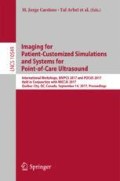Abstract
Automatic liver tumor segmentation is an important step towards digital medical research, clinical diagnosis and therapy planning. However, the existence of noise, low contrast and heterogeneity make the automatic liver tumor segmentation remaining an open challenge. In this work, we focus on a novel automatic method to segment liver tumor in abdomen images from CT scans by using fully convolutional networks (FCN) and non-negative matrix factorization (NMF). We train the FCN for semantic liver and tumor segmentation. The segmented liver and tumor regions of FCN are used as ROI and initialization for the NMF based tumor refinement, respectively. We refine the surfaces of tumors using a 3D deformable model which derived from NMF and driven by local cumulative spectral histograms (LCSH). The refinement is designed to obtain a smoother, more accurate and natural liver tumor surface. Experiments demonstrated that the proposed segmentation method achieves satisfactory results. Likewise, it has been notably observed that the computing time of the segmentation method is no more than one minute for each CT volume.
Access this chapter
Tax calculation will be finalised at checkout
Purchases are for personal use only
References
Becker, M., Magnenat-Thalmann, N.: Deformable models in medical image segmentation. In: Magnenat-Thalmann, N., Ratib, O., Choi, H.F. (eds.) 3D Multiscale Physiological Human, pp. 81–106. Springer, London (2014). doi:10.1007/978-1-4471-6275-9_4
Chan, T.F., Esedoglu, S., Nikolova, M.: Algorithms for finding global minimizers of image segmentation and denoising models. SIAM J. Appl. Math. 66(5), 1632–1648 (2006)
Chen, B., Chen, Y., Yang, G., Meng, J., Zeng, R., Luo, L.: Segmentation of liver tumor via nonlocal active contours. In: 2015 IEEE International Conference on Image Processing (ICIP), pp. 3745–3748. IEEE (2015)
Christ, P.F., et al.: Automatic liver and lesion segmentation in CT using cascaded fully convolutional neural networks and 3D conditional random fields. In: Ourselin, S., Joskowicz, L., Sabuncu, M.R., Unal, G., Wells, W. (eds.) MICCAI 2016. LNCS, vol. 9901, pp. 415–423. Springer, Cham (2016). doi:10.1007/978-3-319-46723-8_48
Gao, M., Chen, H., Zheng, S., Fang, B.: A factorization based active contour model for texture segmentation. In: 2016 IEEE International Conference on Image Processing (ICIP), pp. 4309–4313. IEEE (2016)
Göçeri, E.: Fully automated liver segmentation using sobolev gradient-based level set evolution. Int. J. Numeri. Methods Biomed. Eng. 32(11) (2016)
Goldstein, T., Osher, S.: The split bregman method for l1-regularized problems. SIAM J. Imaging Sci. 2(2), 323–343 (2009)
Götz, M., Heim, E., März, K., Norajitra, T., Hafezi, M., Fard, N., Mehrabi, A., Knoll, M., Weber, C., Maier-Hein, L., Maier-Hein, K.H.: A learning-based, fully automatic liver tumor segmentation pipeline based on sparsely annotated training data. In: Medical Imaging 2016: Image Processing (2016)
Heimann, T., Van Ginneken, B., Styner, M.A., Arzhaeva, Y., Aurich, V., Bauer, C., Beck, A., Becker, C., Beichel, R., Bekes, G.: Comparison and evaluation of methods for liver segmentation from CT datasets. IEEE Trans. Med. Imaging 28(8), 1251–1265 (2009)
Krinidis, S., Chatzis, V.: A robust fuzzy local information C-means clustering algorithm. IEEE Trans. Image Process. 19(5), 1328–1337 (2010)
Li, B.N., Chui, C.K., Chang, S., Ong, S.H.: A new unified level set method for semi-automatic liver tumor segmentation on contrast-enhanced CT images. Expert Syst. Appl. 39(10), 9661–9668 (2012)
Patil, D.D., Deore, S.G.: Medical image segmentation: a review. Int. J. Comput. Sci. Mob. Comput. 2(1), 22–27 (2013)
Shelhamer, E., Long, J., Darrell, T.: Fully convolutional networks for semantic segmentation. IEEE Trans. Pattern Anal. Mach. Intell. 39(4), 640–651 (2017)
Shen, D., Wu, G., Suk, H.I.: Deep learning in medical image analysis. Ann. Rev. Biomed. Eng. 19, 221–248 (2017)
Simonyan, K., Zisserman, A.: Very deep convolutional networks for large-scale image recognition. CoRR abs/1409.1556 (2014)
Yuan, J., Wang, D., Cheriyadat, A.M.: Factorization-based texture segmentation. IEEE Trans. Image Process. 24(11), 3488–3497 (2015)
Zhang, K., Zhang, L., Lam, K.M., Zhang, D.: A level set approach to image segmentation with intensity inhomogeneity. IEEE Trans. Cybernet. 46(2), 546–557 (2016)
Acknowledgments
This research is sponsored by the National Natural Science Foundation of China (61472053, 91420102), Major Program of National Natural Science Foundation of China (No. 61190122), National Key Technology R&D Program of China (No. 2012BAI06B01).
Author information
Authors and Affiliations
Corresponding author
Editor information
Editors and Affiliations
Rights and permissions
Copyright information
© 2017 Springer International Publishing AG
About this paper
Cite this paper
Zheng, S., Fang, B., Li, L., Gao, M., Wang, Y., Peng, K. (2017). Automatic Liver Lesion Segmentation in CT Combining Fully Convolutional Networks and Non-negative Matrix Factorization. In: Cardoso, M., et al. Imaging for Patient-Customized Simulations and Systems for Point-of-Care Ultrasound. BIVPCS POCUS 2017 2017. Lecture Notes in Computer Science(), vol 10549. Springer, Cham. https://doi.org/10.1007/978-3-319-67552-7_6
Download citation
DOI: https://doi.org/10.1007/978-3-319-67552-7_6
Published:
Publisher Name: Springer, Cham
Print ISBN: 978-3-319-67551-0
Online ISBN: 978-3-319-67552-7
eBook Packages: Computer ScienceComputer Science (R0)

